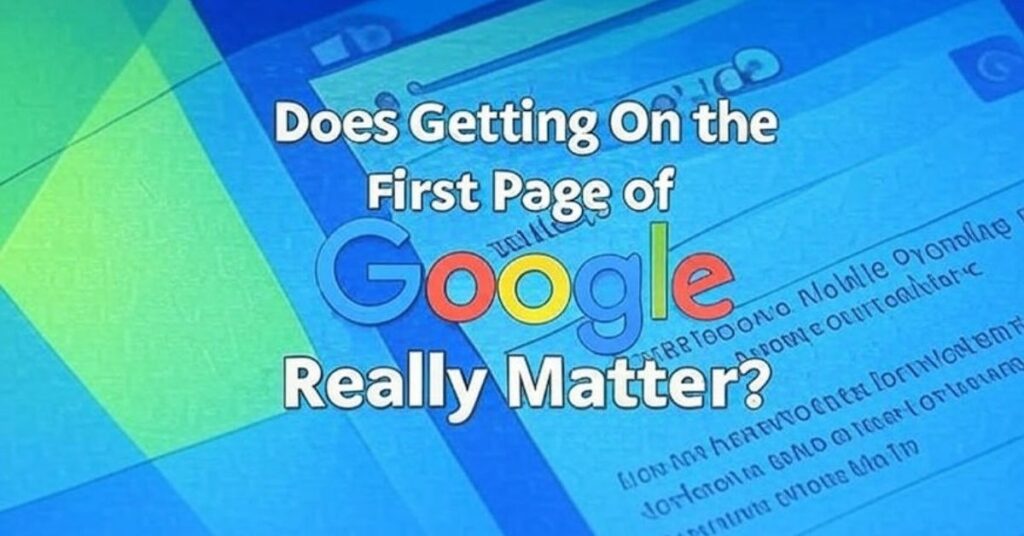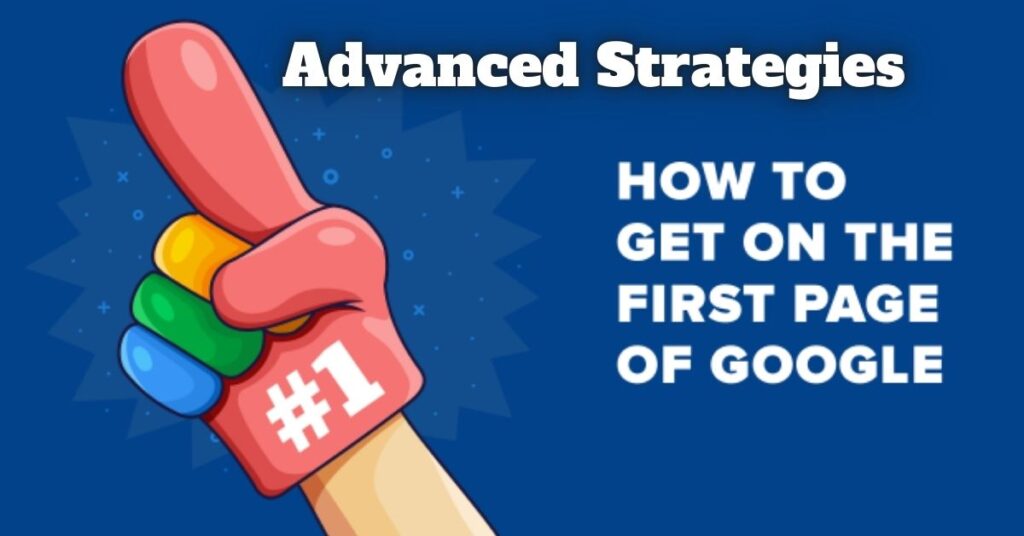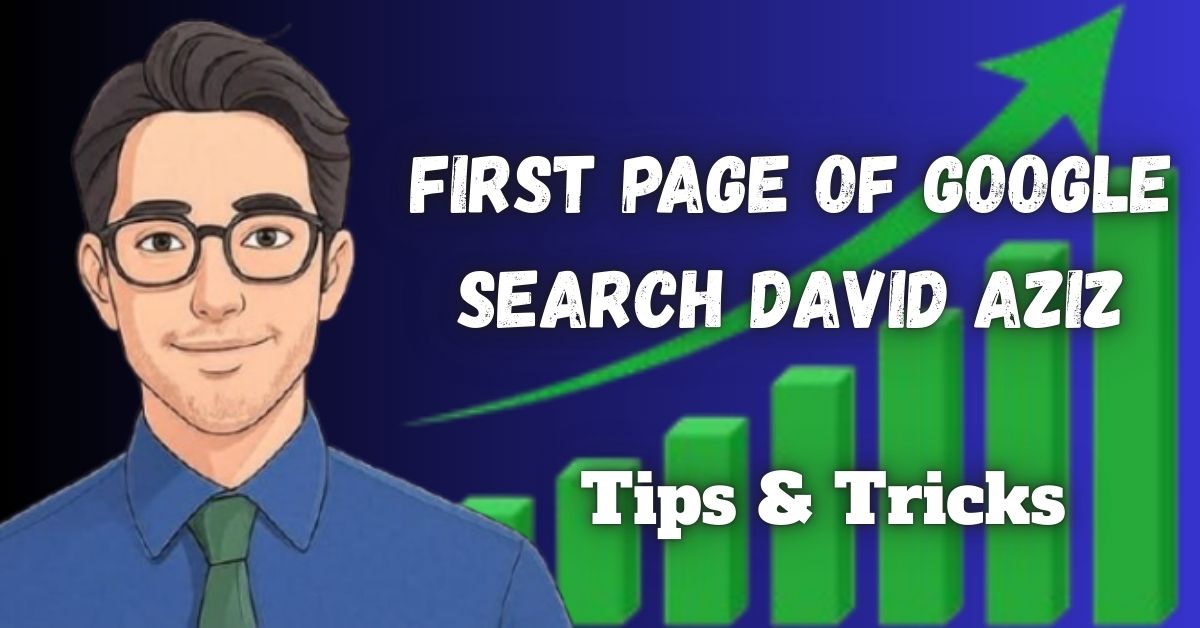Website owners dream of having their site on the first page of Google. With billions of searches every day, ranking higher means more traffic, visibility, and business success. One name that keeps popping up in the SEO circles is David Aziz.
David, one of those few uber-smart folks in digital marketing and SEO who have aided many businesses to attain this fantastic goal, seems to have some secrets of his own which put him way ahead of others in having his clients’ sites ranking on the first page of Google. Let us now see some of the key strategies advocated by David Aziz and fellow SEO professionals.
Why Google’s First Page Matters

Ninety-three percent of total search traffic is farmed from the first page of Google, so without being on it, you’re virtually nonexistent in the online space. Users tend to hardly click on pages beyond the top results, making it critical for you to:
- Brand visibility that builds recognition and trust with potential customers
- Increased traffic flowing to your website from highly interested prospects
- Better conversion rates since users find exactly what they’re searching for
- Competitive advantage over businesses that haven’t optimized their online presence
- Cost-effective marketing that continues working for you 24/7
Being on page one isn’t just about vanity it directly impacts your bottom line. Studies show the first organic result gets nearly 32% of all clicks, while positions 6-10 receive less than 5% combined.
READ THIS BLOG: Newsletter from Shopnaclo: Fresh Finds & Fashion Alerts
Key Elements of Ranking on Google’s First Page
Keyword Research
The foundation of any successful SEO strategy starts with understanding what your audience is searching for. Effective keyword research involves:
- Finding terms with search volume high enough to be worthwhile but not so competitive they’re impossible to rank for
- Identifying long-tail keywords that have lower competition but higher conversion potential
- Analyzing user intent behind searches to create content that truly meets needs
- Monitoring keyword trends to stay ahead of seasonal changes and emerging topics
- Using tools like Ahrefs, SEMrush, or Google’s Keyword Planner to gather actionable data
Remember that the best keywords balance relevance, search volume, and competition level. Don’t just chase high volume termsprioritize those that align with your business objectives and audience needs.
On-Page SEO
On-page optimization signals to Google what your content is about and helps it rank for relevant searches. Focus on these critical elements:
- Create compelling title tags that include your target keyword near the beginning
- Write meta descriptions that encourage clicks while accurately describing the content
- Structure content with proper heading tags (H1, H2, H3) to organize information logically
- Include your keywords in natural, readable ways throughout your content
- Optimize image alt text to improve accessibility and provide additional ranking signals
- Create SEO-friendly URLs that are short, descriptive, and include target keywords
Each page should target a primary keyword and several related secondary terms. Avoid keyword stuffing Google’s algorithms have become sophisticated enough to understand context and synonyms.
High-Quality Content
Content remains king in the SEO world. Google consistently rewards pages that provide genuine value to users with higher rankings. Quality content means:
- Comprehensive coverage that answers all possible questions users might have
- Original insights that can’t be found elsewhere on the internet
- Engaging formats including visuals, videos, and interactive elements
- Up-to-date information that reflects the latest developments in your field
- Readability with proper formatting, short paragraphs, and scannable structure
Content length matters, but quality always trumps quantity. Focus on creating the best resource on your topic rather than hitting arbitrary word counts. The most successful pages satisfy user intent better than competitors.
Mobile Optimization
With Google’s mobile-first indexing, how your site performs on smartphones directly impacts rankings. Prioritize:
- Responsive design that adapts seamlessly to any screen size
- Fast loading times on mobile networks (aim for under 3 seconds)
- Touch-friendly navigation with properly sized buttons and menus
- Readable text without requiring zooming or horizontal scrolling
- Properly functioning interactive elements that work equally well on touchscreens
Google’s mobile-friendly test can help identify issues that might be hurting your mobile experience. Fixing these problems often leads to immediate ranking improvements.
Backlinks
Backlinks remain one of Google’s top ranking factors they act as “votes of confidence” from other websites. A strong backlink profile includes:
- Quality links from authoritative sites in your industry or niche
- Diverse sources rather than multiple links from the same few domains
- Relevant context where the linking page relates to your content topic
- Natural anchor text that varies and doesn’t overuse exact-match keywords
- Earned mentions rather than paid links that violate Google’s guidelines
Focus on creating link worthy content and genuine relationship building rather than quick-fix link schemes that risk penalties. One high-quality backlink often outweighs dozens of low-quality ones.
User Experience (UX)
Google increasingly uses behavioral signals to determine rankings. Sites that provide excellent user experiences tend to rise in search results. Key UX factors include:
- Page speed with fast loading times across all device types
- Intuitive navigation that helps users quickly find what they need
- Limited popup usage that doesn’t interrupt the reading experience
- Minimal ads that don’t overwhelm content or cause layout shifts
- Clear calls to action that guide users toward conversions
Google’s Core Web Vitals metrics now directly impact rankings, measuring loading performance, interactivity, and visual stability. Tools like PageSpeed Insights can help identify specific improvements needed.
Advanced Strategies to Secure a First-Page Ranking

Schema Markup
Schema markup helps search engines understand your content on a deeper level, potentially leading to enhanced search results with rich snippets. Implementing schema can:
- Make your listings stand out with stars, prices, or other visual elements
- Improve click-through rates even without changing your actual ranking position
- Help Google understand complex relationships in your content
- Position your content for featured snippets and other enhanced results
- Create more informative search listings that attract qualified visitors
Focus on markup types most relevant to your business reviews for products, how to for instructional content, FAQ for question pages, and so on.
Voice Search Optimization
As voice assistants grow in popularity, optimizing for spoken queries becomes increasingly important. Effective voice search strategies include:
- Targeting conversational phrases and questions people naturally ask
- Creating concise answers to common questions (40-60 words work best)
- Focusing on local search terms since many voice queries have local intent
- Improving page speed since voice results typically come from fast-loading pages
- The building featured snippet-worthy content as these often become voice answers
Voice search optimization often overlaps with general SEO best practices but emphasizes natural language and direct question answering.
Local SEO
For businesses serving specific geographic areas, local optimization techniques can dramatically improve visibility. Local SEO requires:
- Claiming and optimizing your Google Business Profile with complete information
- Building local citations across relevant directories and platforms
- Encouraging satisfied customers to leave positive reviews
- Creating location-specific pages with local keywords and information
- Earning backlinks from local sources like community organizations or newspapers
Local search results often appear above traditional organic listings, making this strategy particularly valuable for businesses with physical locations.
READ THIS BLOG: Enhance Your Microsoft Lync Experience with Lync Conf Mods
Common SEO Mistakes to Avoid
Even experienced marketers make mistakes that can hamper ranking progress. Watch out for these common pitfalls:
- Neglecting technical SEO fundamentals like crawlability and indexing
- Publishing thin content that doesn’t fully address user needs
- Ignoring mobile users with desktop-only optimization
- Overlooking page speed issues that frustrate visitors
- Building low-quality backlinks that risk penalties
- Targeting overly competitive keywords without building authority first
- Failing to analyze performance data to guide ongoing improvements
The most successful SEO strategies involve continuous learning and adjustment. What worked last year may not work today as Google’s algorithms evolve.
Frequently Asked Questions
How often should I create new content to improve my rankings?
Quality before quantity has to be the motto. One or two excellent pieces a month generally outperform the daily posting of something mediocre.
What is a bounce rate, and does it affect SEO?
Bounce rate measures visitors who leave without further interaction. While not a direct ranking factor, high bounce rates may indicate content quality issues that indirectly affect SEO by signaling a poor user experience to Google.
How does site speed affect SEO?
The speed of the site is directly an influencing factor for ranking based on Core Web Vitals metrics. Hence, sites that are fast gain exceptional rank because of the superior user experience they offer.
Does Google penalize duplicate content?
Duplicate content is not a “penalty” as per Google; it usually filters out versions that are similar. In most cases, only one of these can be shown in the search results.
Can video content help me rank on the first page of Google?
Media content attracts more engagement, sometimes appearing in normal search results, and video carousels thereby doubling your chances of visibility.
Conclusion
It does require serious combinations of technical expertise, quality content, and strategic promotion to make it to the first page of Google. The crux of the matter lies in striking a balance between these three focuses without losing sight of one dear user value.
SEO tends to be a marathon and not a sprint. Time is taken and results turn up in due course, but that compound effect of consistent transformation will take some years to show its magic to online visibility and business growth.
This should make you get into almost all other strategies from this guide as you will be learning newer techniques in the progress of time, thus creating a sustainable search success for you.

Smith is a seasoned SEO expert with a passion for content writing, keyword research, and web development. He combines technical expertise with creative strategies to deliver exceptional digital solutions.















